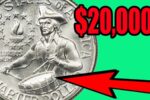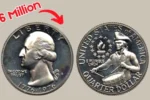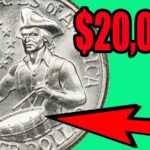The Rare Bicentennial Quarter Valued at $1 Million, Still in Circulation
Imagine spending 25 cents on a soda and later finding out that same quarter could’ve been worth $1 million. Sounds like a movie scene, right? But in the world of coin collecting, that’s not far from reality. The Bicentennial Quarter, released in 1976, has become one of the most talked-about coins in recent years. While most are only worth face value, a rare version of this quarter is rumored to be valued at $1 million — and it might still be in circulation.
So what’s the story behind this famous coin? How can a common-looking quarter hold such a high value? And more importantly, how can you spot one? This article explains it all in clear, simple terms.
Overview Table – Rare Bicentennial Quarter Details
| Feature | Details |
|---|---|
| Coin Name | 1976 Bicentennial Quarter |
| Design | Drummer boy on reverse, “1776–1976” date |
| Mint Years | 1975–1976 |
| Face Value | $0.25 |
| Rare Value | Up to $1 million |
| Reason for High Value | Minting error, rare metal, perfect grade |
| Still in Circulation? | Yes, but extremely rare |
Design & Historical Background
To celebrate the 200th anniversary of American independence, the U.S. Mint introduced a special edition of the quarter in 1976. Instead of the usual eagle on the back, it featured a drummer boy with a torch and stars, designed by Jack L. Ahr. The front kept George Washington’s profile but changed the date to “1776–1976.”
This patriotic coin was part of a larger celebration and was minted in huge numbers — billions, to be exact. Because of that, most Bicentennial Quarters are still very common today. But not all of them are the same.
Why Is One Worth $1 Million?
So, why is a coin that was printed in the billions suddenly being valued at $1 million? The answer lies in rarity, condition, and errors. Here are the top reasons:
1. Minting Errors
Some coins were struck with errors during the minting process. These mistakes, such as being printed on the wrong type of metal (called a “planchet”), make them extremely rare.
For example, a Bicentennial Quarter accidentally struck on a silver or experimental planchet rather than the regular copper-nickel blend is one of the coins that collectors are after.
2. Perfect Condition (MS-70)
Coins are graded on a scale from 1 to 70. A coin graded MS-70 (Mint State 70) means it’s in absolutely perfect condition. These are extremely rare, especially for coins that have been in circulation for almost 50 years.
A Bicentennial Quarter with a minting error in MS-70 condition could be what pushes its value up to the $1 million mark.
3. Unique Features
Other rare features may include:
-
Double die errors (where parts of the design appear twice)
-
Off-center strikes
-
No mint mark (indicating unusual production)
All of these contribute to the coin’s scarcity and desirability among collectors.
How to Spot the Rare Bicentennial Quarter
Even though rare versions of the coin are few, some people still find unique coins in pocket change, old jars, or coin collections. Here’s what to look for:
-
Date “1776–1976” on the front of the coin.
-
Drummer boy on the reverse side.
-
Look for unusual colors or shine — silver coins look different from regular ones.
-
Use a magnet: regular quarters are not magnetic, but this helps identify some metal differences.
-
Check the edges: A silver coin will have a clean silver edge, while normal ones show copper layering.
-
Look closely for doubling in letters or numbers.
If anything looks odd or too perfect, don’t spend it — have it checked by a professional.
Could It Still Be in Circulation?
Yes, it’s possible — though very unlikely. The U.S. Mint never recalled Bicentennial Quarters, and many of them are still used in everyday transactions. That means someone could have unknowingly spent a rare version without realizing it.
Coin experts believe that a few rare quarters may still be out there, either sitting in a piggy bank, an old drawer, or in a coin roll from the bank.
So next time you get change, check your quarters — especially if they have that “1776–1976” date.
FAQs – Frequently Asked Questions
1. Are all Bicentennial Quarters valuable?
No. Most are worth just face value, around 25 cents. Only specific rare versions with errors, silver content, or perfect condition are worth big money.
2. How can I tell if my quarter is silver?
Check the edge. If the edge is solid silver with no copper stripes, it might be silver. You can also weigh it — silver quarters are heavier than regular ones.
3. What does “MS-70” mean?
MS-70 is a Mint State grade given to coins in perfect condition. It’s extremely rare, especially for older coins.
4. Where can I sell a rare coin?
You can sell it through coin dealers, auctions, or online platforms. Make sure it’s graded and certified first by a company like PCGS or NGC.
5. Can I still find a rare quarter in my pocket change?
Yes, although it’s very rare. People still find valuable coins in circulation from time to time. Always keep an eye out!
Final Verdict
The rare Bicentennial Quarter valued at $1 million is a perfect example of how something ordinary can turn out to be extraordinary. While most of these coins are common, a small number of them — with unique minting errors, rare metal content, or perfect condition — are considered treasures in the world of numismatics (coin collecting).
If you’re someone who uses cash regularly, checks coin jars, or even picks up change off the ground, keep your eyes open. One of those old “drummer boy” quarters could turn out to be the million-dollar coin everyone is dreaming of.













